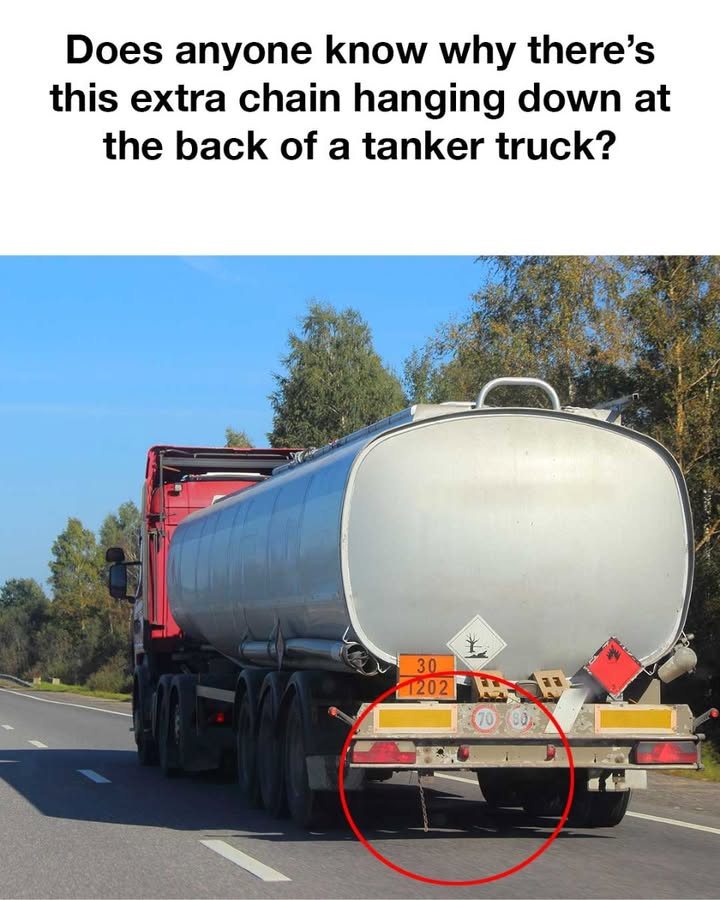Tanker trucks are specially designed vehicles built to transport a variety of liquid and gas products, including fuel, chemicals, water, and food-grade substances. They feature a large cylindrical tank mounted on a chassis that is specifically engineered to contain and safely deliver potentially hazardous materials.

These vehicles incorporate a number of safety mechanisms to ensure the secure transportation of their cargo, and one of the least noticeable—but most important—features is a metal chain that often hangs down at the back of the truck. While this dangling chain might seem unnecessary or decorative to the casual observer, it actually plays a critical role in the truck’s safety operations. This chain serves as a grounding device, designed to dissipate static electricity that builds up during the movement of the truck and its contents.
As fuel and other flammable liquids shift inside the metal tank, friction occurs between the liquid and the container’s interior, which creates a buildup of static electricity. Combined with the movement of the truck on the road, this static charge can become quite dangerous. If not grounded properly, the charge can discharge in the form of a spark—an event that could ignite flammable vapors and potentially cause catastrophic fires or explosions. The trailing chain ensures this doesn’t happen by maintaining contact with the ground, allowing any static electricity to discharge safely into the earth.
This practice of grounding tanker trucks became standard after a series of tragic incidents in the early days of liquid fuel transport, where static discharges led to devastating accidents. As understanding of static electricity and its risks improved, regulatory bodies stepped in to enforce better safety standards. The grounding chain proved to be a simple, low-cost, and highly effective method to mitigate static discharge risks. Today, it remains a standard requirement across the industry, reinforced by stringent safety codes and regulations, particularly in countries like the United States where the Department of Transportation mandates thorough guidelines for hazardous materials transport. These rules cover everything from tank materials and pressure tolerances to systems that prevent and manage static buildup.
The grounding chain is inspected regularly as part of these safety protocols to ensure it’s still effective and in working condition. Scientifically, static electricity is the result of an imbalance of charges caused when materials come into contact and then separate. In tanker trucks, the constant sloshing of liquid against the tank walls, combined with the vibrations and movement of driving, creates prime conditions for static buildup. This is why grounding is so essential. By using the chain to give the charge a safe path to the earth, the truck prevents dangerous sparks. While the chain is the most traditional form of grounding, modern alternatives are also used in today’s tanker fleets. For instance, static grounding reels are retractable cables that can be attached to a grounding point during fuel transfer. Additionally, anti-static additives may be blended into the fuel to reduce friction-induced charge. In some cases, specialized tank coatings or materials that resist static generation are implemented for added safety. Despite these innovations, the humble chain remains in use due to its reliability and simplicity. A widespread misconception is that the chain is leftover hardware or a stabilizing tool, which is far from true. It is not involved in braking, steering, or truck stability in any mechanical way. Instead, it’s a silent guardian against the invisible threat of static sparks. Maintaining this chain is equally important as having it. Over time, it can suffer from wear, corrosion, or damage, which can reduce its effectiveness. It needs to maintain solid contact with the ground to function properly. During routine vehicle inspections, crews check the chain for length, grounding efficiency, and structural integrity. Any compromised links must be replaced immediately to ensure continuous protection. In summary, the extra chain hanging from the rear of a tanker truck is not an insignificant afterthought but a critical safety feature. Its main function—grounding static electricity—helps prevent fires and explosions during the transport of volatile liquids. Though simple in design, it’s backed by decades of engineering, regulatory support, and practical application. Understanding what this chain does and ensuring it remains in good condition can make a crucial difference in preventing accidents and protecting lives, property, and the environment every single day the truck is on the road.





